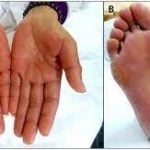Table of Contents
What is hand foot syndrome?

Hand-foot syndrome is characterized by redness, swelling, and tingling in the palms of the hands or the soles of the feet. It is also known as Palmar-plantar erythrodysesthesia syndrome. The syndrome is a side effect of cancer treatments. It causes redness, blisters, swelling, and pain on the palms of the hands and/or the soles of the feet. Hand-foot syndrome sometimes affects the knees or elbows. It is worse during the first 6 weeks of targeted therapy treatment. With chemotherapy, it appears after 2 to 3 months.
It is a skin reaction that occurs when a small amount of the medication leaks out of capillaries (small blood vessels), usually on the palms of the hands and soles of the feet. When the medication leaks out of the capillaries, it can damage the surrounding tissues. The hand-foot syndrome can be painful. It can also affect your daily living.
How bad is my hand foot syndrome?
Mild: Minimal skin changes (swelling, redness, tingling, dermatitis) without pain.
Moderate: You may have moderate skin changes (e.g., peeling, blisters, bleeding, fissures, edema, or hyperkeratosis) with pain. It may limit your instrumental activities of daily life (preparing meals, managing money, shopping, doing housework, and using a telephone).
Severe: Skin changes (e.g., cracking, ulcers, sores) with unbearable pain. You may experience difficulty while walking or using your hands. It may limit your self-care activities of daily life (eating, dressing, getting into or out of a bed or chair, taking a bath or shower, and using the toilet). It requires treatment under your doctor’s supervision.
How to manage mild hand foot syndrome?
Keep track of skin changes using Ankr (myAnkr web portal or the Ankr app). It will help you describe the discomfort to your doctor or nurse.
- Limit the use of hot water when bathing.
- Take cool showers or baths. Carefully pat dry skin after washing or bathing.
- Cool your hands and feet. Use ice packs, cool running water, or a wet towel for 15 to 20 minutes at a time. Never apply ice directly to the skin.
- Avoid sources of heat (saunas, sitting in the sun, or sitting in front of a sunny window).
- Restrict activities (jogging, aerobics, and racquet sports.) that cause force or rubbing on the hands or feet during the first 6 weeks of treatment.
- Avoid contact with harsh chemicals used in laundry detergents or household cleaning products.
- Never use tools or household items (garden tools, knives, and screwdrivers) that require you to press your hand against a hard surface.
- Avoid rubbing or massaging lotion into your hands and feet.
- Wear loose fitting, well-ventilated shoes and clothes.
- Use soft slippers and thick socks to reduce friction on your feet.
How to manage moderate and severe hand foot syndrome?
If you notice early signs or if you notice your symptoms worsening, call your doctor’s office. Your health care team may need to change your treatment or help you manage the symptom.
What are the causes?
- Chemotherapy drugs (Fluorouracil, Capecitabine)
- Targeted therapy
